Business Economics Report: Analysis of Tesco Plc and UK Economy
VerifiedAdded on 2020/07/23
|24
|8062
|129
Report
AI Summary
This report provides a comprehensive analysis of business economics, using Tesco Plc as a case study within the context of the UK economy. It begins with an introduction to the economic problem of scarcity and demand resource allocation, followed by an examination of market equilibrium and the importance of different market systems. The report delves into the implications of pricing and objectives on business operations, comparing price setting in various market structures and analyzing firm behaviors. It further explores macroeconomic policy challenges, government policies, and the economic performance of an economy in the global market. The report also covers the theory of comparative advantage, the advantages and disadvantages of free trade, and the impact of emerging economies and economic shocks. The analysis incorporates relevant illustrations and concludes with a summary of key findings and references.
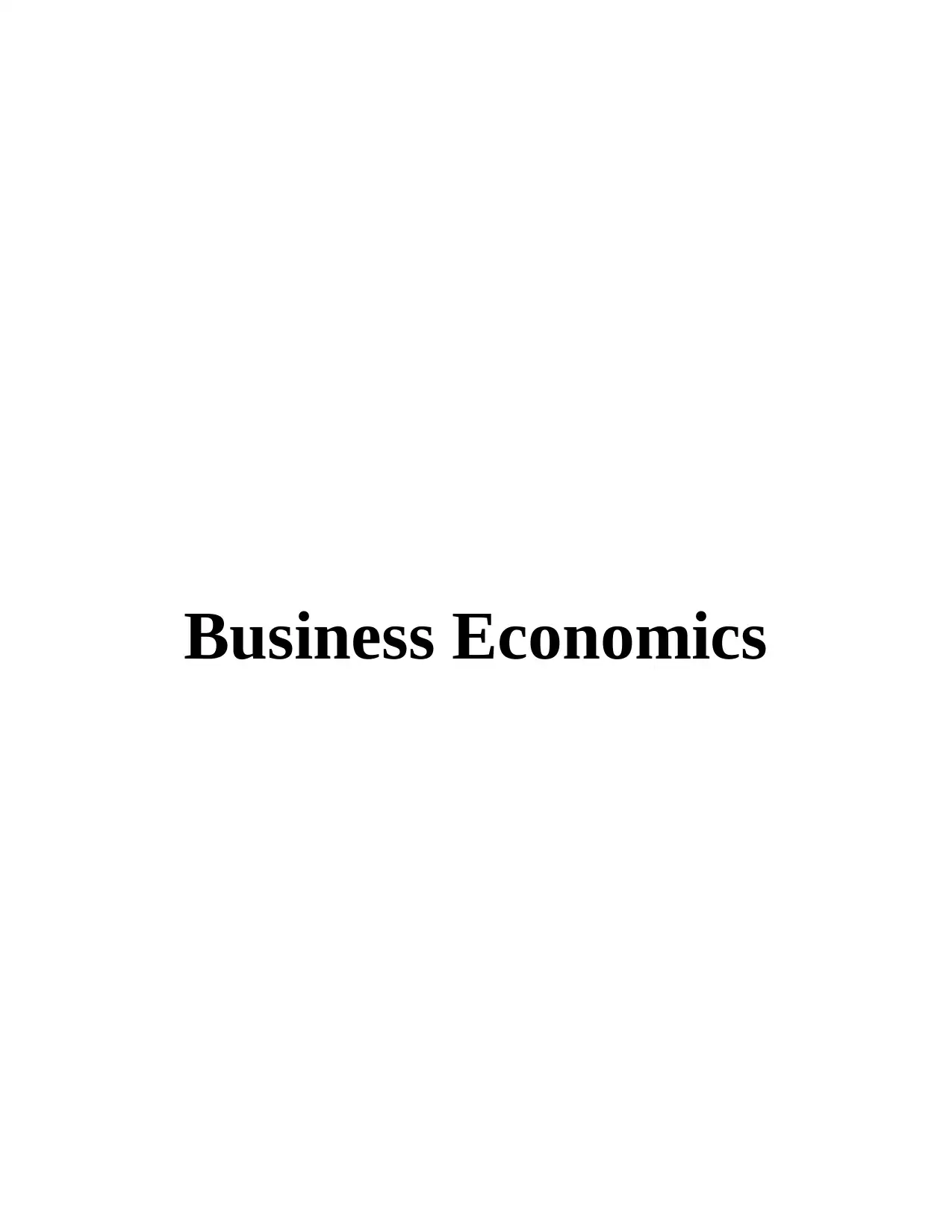
Business Economics
Paraphrase This Document
Need a fresh take? Get an instant paraphrase of this document with our AI Paraphraser
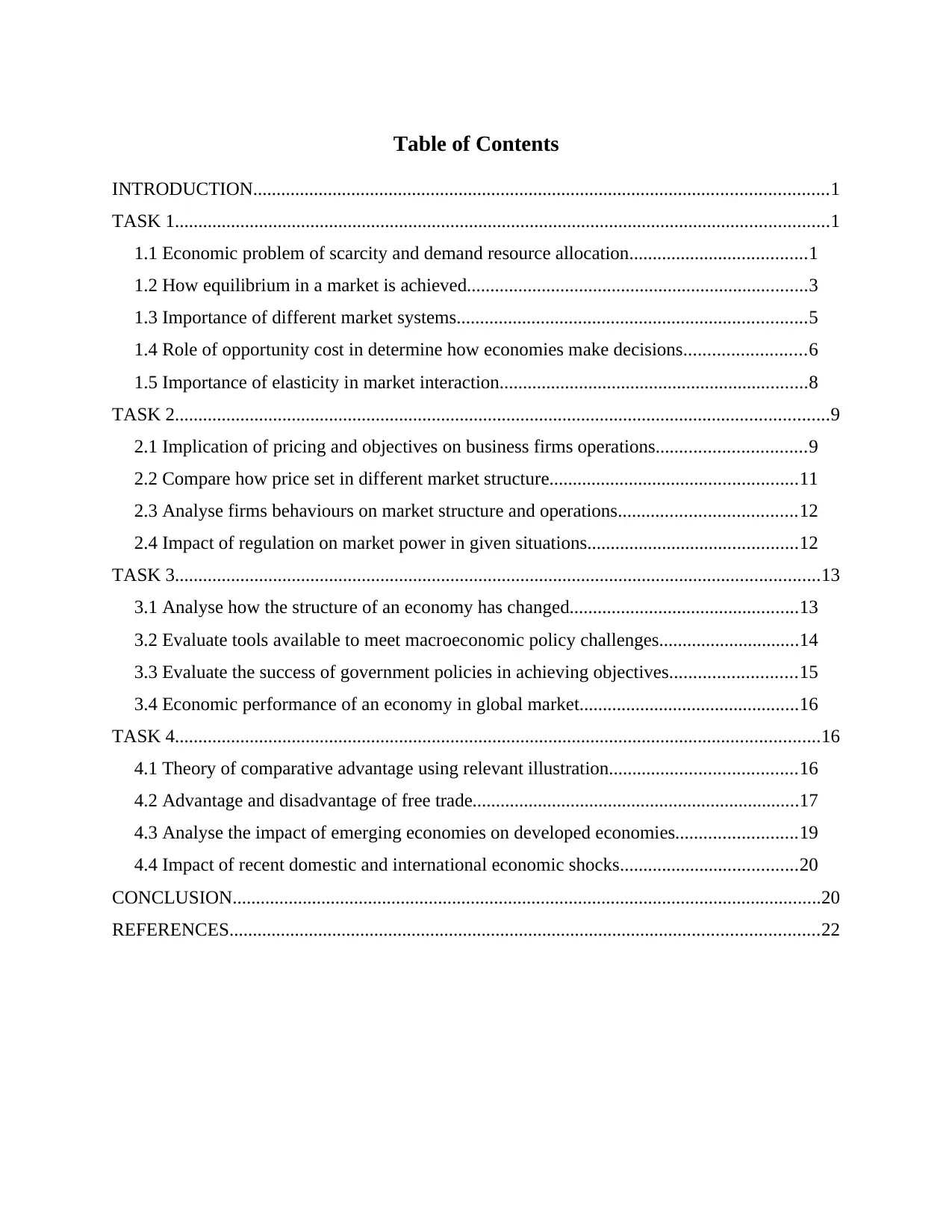
Table of Contents
INTRODUCTION...........................................................................................................................1
TASK 1............................................................................................................................................1
1.1 Economic problem of scarcity and demand resource allocation......................................1
1.2 How equilibrium in a market is achieved.........................................................................3
1.3 Importance of different market systems...........................................................................5
1.4 Role of opportunity cost in determine how economies make decisions..........................6
1.5 Importance of elasticity in market interaction..................................................................8
TASK 2............................................................................................................................................9
2.1 Implication of pricing and objectives on business firms operations................................9
2.2 Compare how price set in different market structure.....................................................11
2.3 Analyse firms behaviours on market structure and operations......................................12
2.4 Impact of regulation on market power in given situations.............................................12
TASK 3..........................................................................................................................................13
3.1 Analyse how the structure of an economy has changed.................................................13
3.2 Evaluate tools available to meet macroeconomic policy challenges..............................14
3.3 Evaluate the success of government policies in achieving objectives...........................15
3.4 Economic performance of an economy in global market...............................................16
TASK 4..........................................................................................................................................16
4.1 Theory of comparative advantage using relevant illustration........................................16
4.2 Advantage and disadvantage of free trade......................................................................17
4.3 Analyse the impact of emerging economies on developed economies..........................19
4.4 Impact of recent domestic and international economic shocks......................................20
CONCLUSION..............................................................................................................................20
REFERENCES..............................................................................................................................22
INTRODUCTION...........................................................................................................................1
TASK 1............................................................................................................................................1
1.1 Economic problem of scarcity and demand resource allocation......................................1
1.2 How equilibrium in a market is achieved.........................................................................3
1.3 Importance of different market systems...........................................................................5
1.4 Role of opportunity cost in determine how economies make decisions..........................6
1.5 Importance of elasticity in market interaction..................................................................8
TASK 2............................................................................................................................................9
2.1 Implication of pricing and objectives on business firms operations................................9
2.2 Compare how price set in different market structure.....................................................11
2.3 Analyse firms behaviours on market structure and operations......................................12
2.4 Impact of regulation on market power in given situations.............................................12
TASK 3..........................................................................................................................................13
3.1 Analyse how the structure of an economy has changed.................................................13
3.2 Evaluate tools available to meet macroeconomic policy challenges..............................14
3.3 Evaluate the success of government policies in achieving objectives...........................15
3.4 Economic performance of an economy in global market...............................................16
TASK 4..........................................................................................................................................16
4.1 Theory of comparative advantage using relevant illustration........................................16
4.2 Advantage and disadvantage of free trade......................................................................17
4.3 Analyse the impact of emerging economies on developed economies..........................19
4.4 Impact of recent domestic and international economic shocks......................................20
CONCLUSION..............................................................................................................................20
REFERENCES..............................................................................................................................22

⊘ This is a preview!⊘
Do you want full access?
Subscribe today to unlock all pages.

Trusted by 1+ million students worldwide
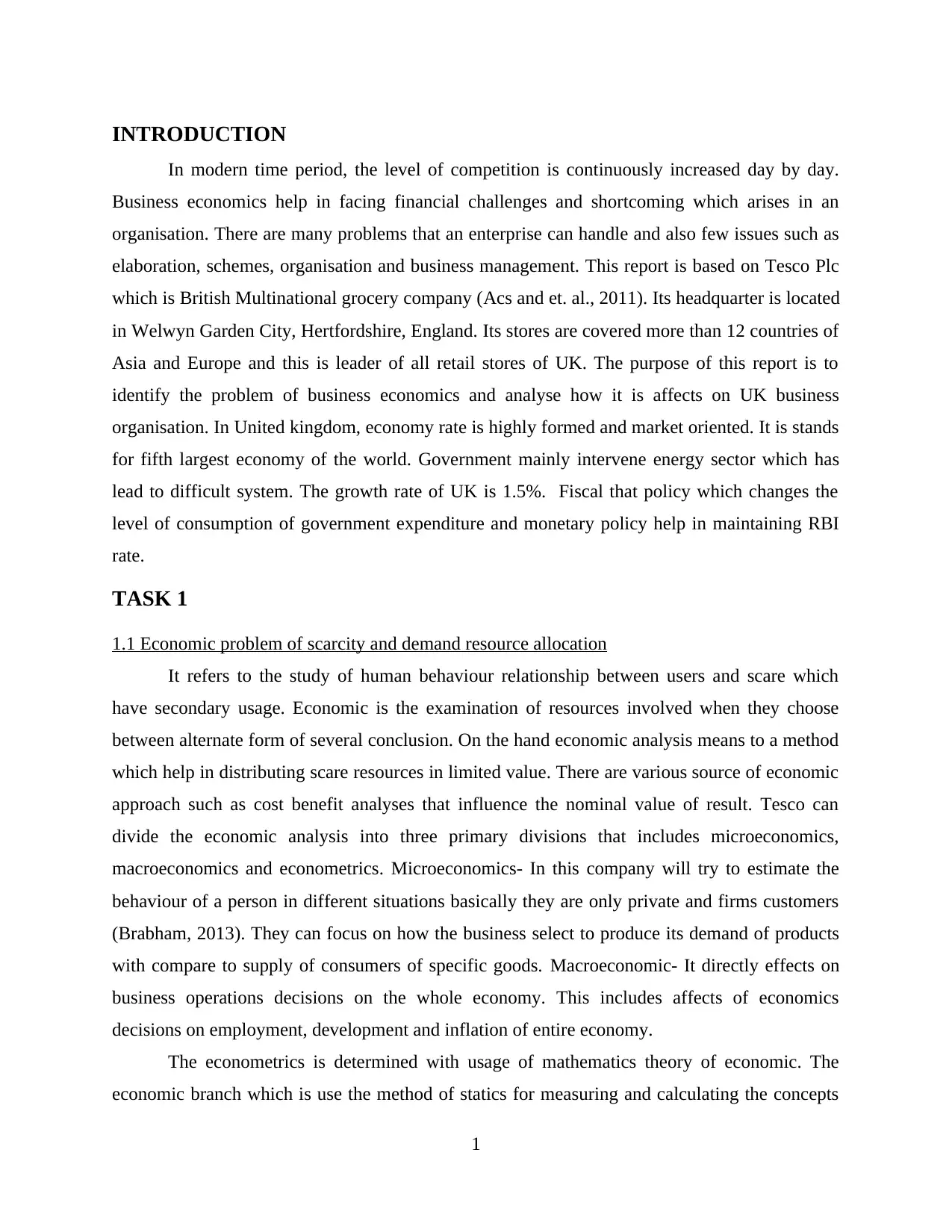
INTRODUCTION
In modern time period, the level of competition is continuously increased day by day.
Business economics help in facing financial challenges and shortcoming which arises in an
organisation. There are many problems that an enterprise can handle and also few issues such as
elaboration, schemes, organisation and business management. This report is based on Tesco Plc
which is British Multinational grocery company (Acs and et. al., 2011). Its headquarter is located
in Welwyn Garden City, Hertfordshire, England. Its stores are covered more than 12 countries of
Asia and Europe and this is leader of all retail stores of UK. The purpose of this report is to
identify the problem of business economics and analyse how it is affects on UK business
organisation. In United kingdom, economy rate is highly formed and market oriented. It is stands
for fifth largest economy of the world. Government mainly intervene energy sector which has
lead to difficult system. The growth rate of UK is 1.5%. Fiscal that policy which changes the
level of consumption of government expenditure and monetary policy help in maintaining RBI
rate.
TASK 1
1.1 Economic problem of scarcity and demand resource allocation
It refers to the study of human behaviour relationship between users and scare which
have secondary usage. Economic is the examination of resources involved when they choose
between alternate form of several conclusion. On the hand economic analysis means to a method
which help in distributing scare resources in limited value. There are various source of economic
approach such as cost benefit analyses that influence the nominal value of result. Tesco can
divide the economic analysis into three primary divisions that includes microeconomics,
macroeconomics and econometrics. Microeconomics- In this company will try to estimate the
behaviour of a person in different situations basically they are only private and firms customers
(Brabham, 2013). They can focus on how the business select to produce its demand of products
with compare to supply of consumers of specific goods. Macroeconomic- It directly effects on
business operations decisions on the whole economy. This includes affects of economics
decisions on employment, development and inflation of entire economy.
The econometrics is determined with usage of mathematics theory of economic. The
economic branch which is use the method of statics for measuring and calculating the concepts
1
In modern time period, the level of competition is continuously increased day by day.
Business economics help in facing financial challenges and shortcoming which arises in an
organisation. There are many problems that an enterprise can handle and also few issues such as
elaboration, schemes, organisation and business management. This report is based on Tesco Plc
which is British Multinational grocery company (Acs and et. al., 2011). Its headquarter is located
in Welwyn Garden City, Hertfordshire, England. Its stores are covered more than 12 countries of
Asia and Europe and this is leader of all retail stores of UK. The purpose of this report is to
identify the problem of business economics and analyse how it is affects on UK business
organisation. In United kingdom, economy rate is highly formed and market oriented. It is stands
for fifth largest economy of the world. Government mainly intervene energy sector which has
lead to difficult system. The growth rate of UK is 1.5%. Fiscal that policy which changes the
level of consumption of government expenditure and monetary policy help in maintaining RBI
rate.
TASK 1
1.1 Economic problem of scarcity and demand resource allocation
It refers to the study of human behaviour relationship between users and scare which
have secondary usage. Economic is the examination of resources involved when they choose
between alternate form of several conclusion. On the hand economic analysis means to a method
which help in distributing scare resources in limited value. There are various source of economic
approach such as cost benefit analyses that influence the nominal value of result. Tesco can
divide the economic analysis into three primary divisions that includes microeconomics,
macroeconomics and econometrics. Microeconomics- In this company will try to estimate the
behaviour of a person in different situations basically they are only private and firms customers
(Brabham, 2013). They can focus on how the business select to produce its demand of products
with compare to supply of consumers of specific goods. Macroeconomic- It directly effects on
business operations decisions on the whole economy. This includes affects of economics
decisions on employment, development and inflation of entire economy.
The econometrics is determined with usage of mathematics theory of economic. The
economic branch which is use the method of statics for measuring and calculating the concepts
1
Paraphrase This Document
Need a fresh take? Get an instant paraphrase of this document with our AI Paraphraser
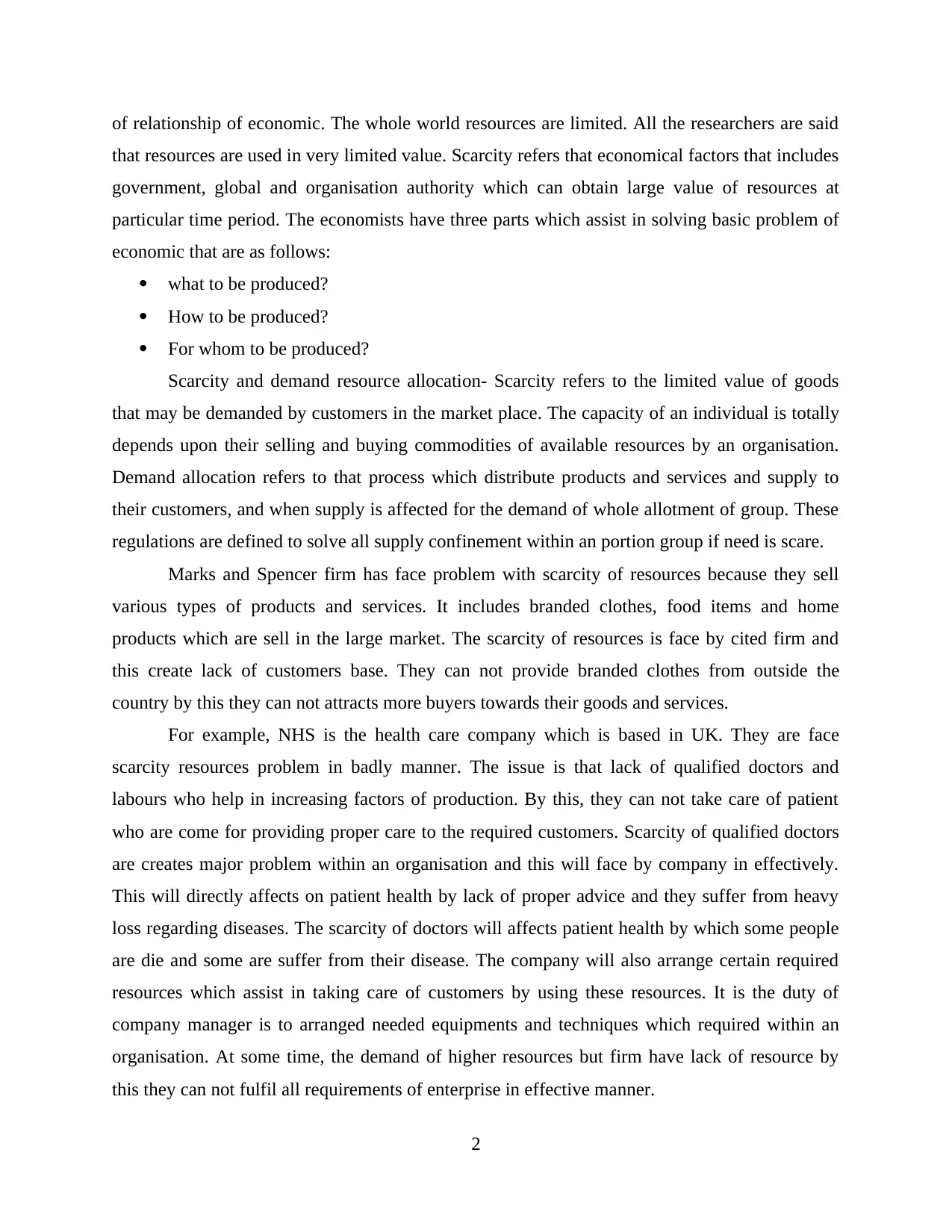
of relationship of economic. The whole world resources are limited. All the researchers are said
that resources are used in very limited value. Scarcity refers that economical factors that includes
government, global and organisation authority which can obtain large value of resources at
particular time period. The economists have three parts which assist in solving basic problem of
economic that are as follows:
what to be produced?
How to be produced?
For whom to be produced?
Scarcity and demand resource allocation- Scarcity refers to the limited value of goods
that may be demanded by customers in the market place. The capacity of an individual is totally
depends upon their selling and buying commodities of available resources by an organisation.
Demand allocation refers to that process which distribute products and services and supply to
their customers, and when supply is affected for the demand of whole allotment of group. These
regulations are defined to solve all supply confinement within an portion group if need is scare.
Marks and Spencer firm has face problem with scarcity of resources because they sell
various types of products and services. It includes branded clothes, food items and home
products which are sell in the large market. The scarcity of resources is face by cited firm and
this create lack of customers base. They can not provide branded clothes from outside the
country by this they can not attracts more buyers towards their goods and services.
For example, NHS is the health care company which is based in UK. They are face
scarcity resources problem in badly manner. The issue is that lack of qualified doctors and
labours who help in increasing factors of production. By this, they can not take care of patient
who are come for providing proper care to the required customers. Scarcity of qualified doctors
are creates major problem within an organisation and this will face by company in effectively.
This will directly affects on patient health by lack of proper advice and they suffer from heavy
loss regarding diseases. The scarcity of doctors will affects patient health by which some people
are die and some are suffer from their disease. The company will also arrange certain required
resources which assist in taking care of customers by using these resources. It is the duty of
company manager is to arranged needed equipments and techniques which required within an
organisation. At some time, the demand of higher resources but firm have lack of resource by
this they can not fulfil all requirements of enterprise in effective manner.
2
that resources are used in very limited value. Scarcity refers that economical factors that includes
government, global and organisation authority which can obtain large value of resources at
particular time period. The economists have three parts which assist in solving basic problem of
economic that are as follows:
what to be produced?
How to be produced?
For whom to be produced?
Scarcity and demand resource allocation- Scarcity refers to the limited value of goods
that may be demanded by customers in the market place. The capacity of an individual is totally
depends upon their selling and buying commodities of available resources by an organisation.
Demand allocation refers to that process which distribute products and services and supply to
their customers, and when supply is affected for the demand of whole allotment of group. These
regulations are defined to solve all supply confinement within an portion group if need is scare.
Marks and Spencer firm has face problem with scarcity of resources because they sell
various types of products and services. It includes branded clothes, food items and home
products which are sell in the large market. The scarcity of resources is face by cited firm and
this create lack of customers base. They can not provide branded clothes from outside the
country by this they can not attracts more buyers towards their goods and services.
For example, NHS is the health care company which is based in UK. They are face
scarcity resources problem in badly manner. The issue is that lack of qualified doctors and
labours who help in increasing factors of production. By this, they can not take care of patient
who are come for providing proper care to the required customers. Scarcity of qualified doctors
are creates major problem within an organisation and this will face by company in effectively.
This will directly affects on patient health by lack of proper advice and they suffer from heavy
loss regarding diseases. The scarcity of doctors will affects patient health by which some people
are die and some are suffer from their disease. The company will also arrange certain required
resources which assist in taking care of customers by using these resources. It is the duty of
company manager is to arranged needed equipments and techniques which required within an
organisation. At some time, the demand of higher resources but firm have lack of resource by
this they can not fulfil all requirements of enterprise in effective manner.
2
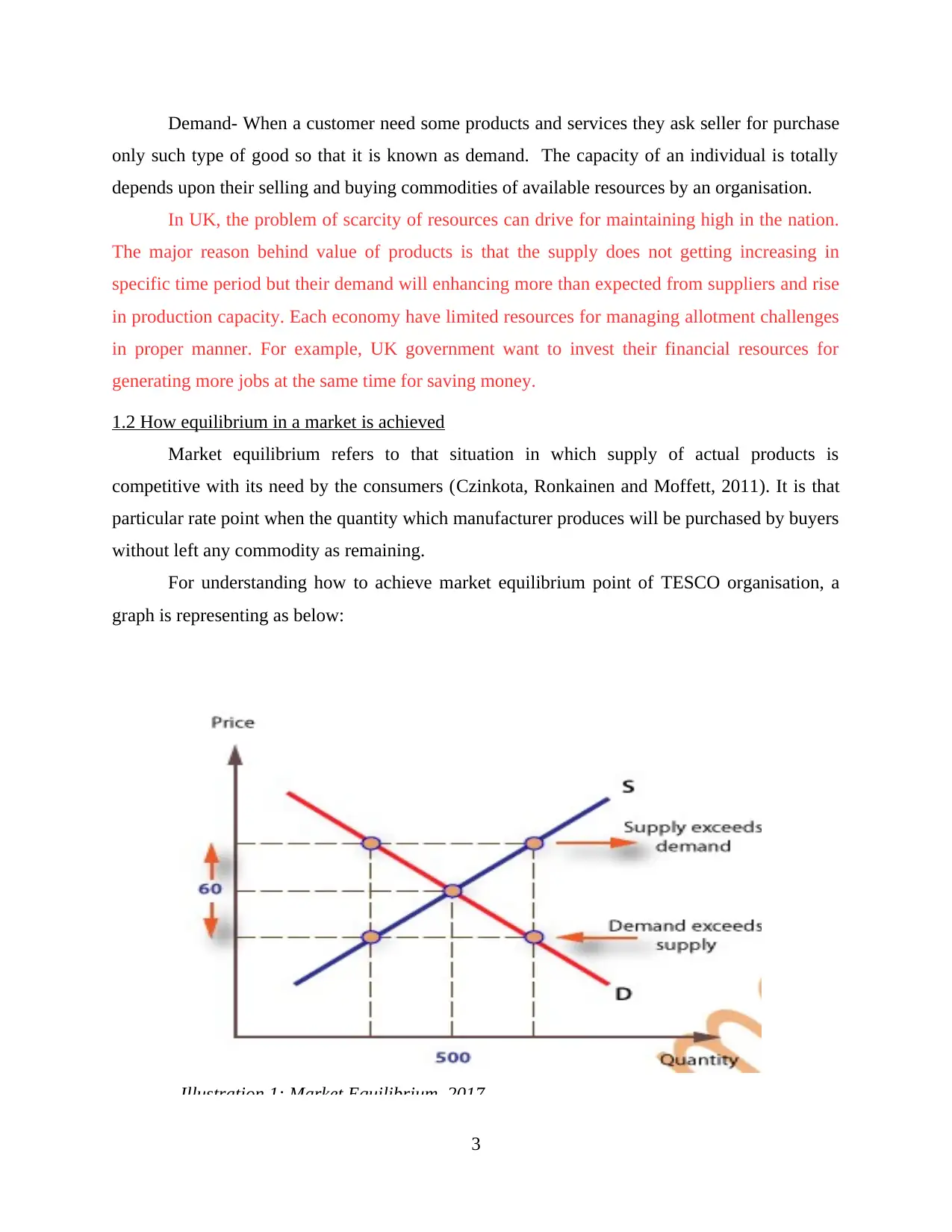
Demand- When a customer need some products and services they ask seller for purchase
only such type of good so that it is known as demand. The capacity of an individual is totally
depends upon their selling and buying commodities of available resources by an organisation.
In UK, the problem of scarcity of resources can drive for maintaining high in the nation.
The major reason behind value of products is that the supply does not getting increasing in
specific time period but their demand will enhancing more than expected from suppliers and rise
in production capacity. Each economy have limited resources for managing allotment challenges
in proper manner. For example, UK government want to invest their financial resources for
generating more jobs at the same time for saving money.
1.2 How equilibrium in a market is achieved
Market equilibrium refers to that situation in which supply of actual products is
competitive with its need by the consumers (Czinkota, Ronkainen and Moffett, 2011). It is that
particular rate point when the quantity which manufacturer produces will be purchased by buyers
without left any commodity as remaining.
For understanding how to achieve market equilibrium point of TESCO organisation, a
graph is representing as below:
3
Illustration 1: Market Equilibrium, 2017
only such type of good so that it is known as demand. The capacity of an individual is totally
depends upon their selling and buying commodities of available resources by an organisation.
In UK, the problem of scarcity of resources can drive for maintaining high in the nation.
The major reason behind value of products is that the supply does not getting increasing in
specific time period but their demand will enhancing more than expected from suppliers and rise
in production capacity. Each economy have limited resources for managing allotment challenges
in proper manner. For example, UK government want to invest their financial resources for
generating more jobs at the same time for saving money.
1.2 How equilibrium in a market is achieved
Market equilibrium refers to that situation in which supply of actual products is
competitive with its need by the consumers (Czinkota, Ronkainen and Moffett, 2011). It is that
particular rate point when the quantity which manufacturer produces will be purchased by buyers
without left any commodity as remaining.
For understanding how to achieve market equilibrium point of TESCO organisation, a
graph is representing as below:
3
Illustration 1: Market Equilibrium, 2017
⊘ This is a preview!⊘
Do you want full access?
Subscribe today to unlock all pages.

Trusted by 1+ million students worldwide
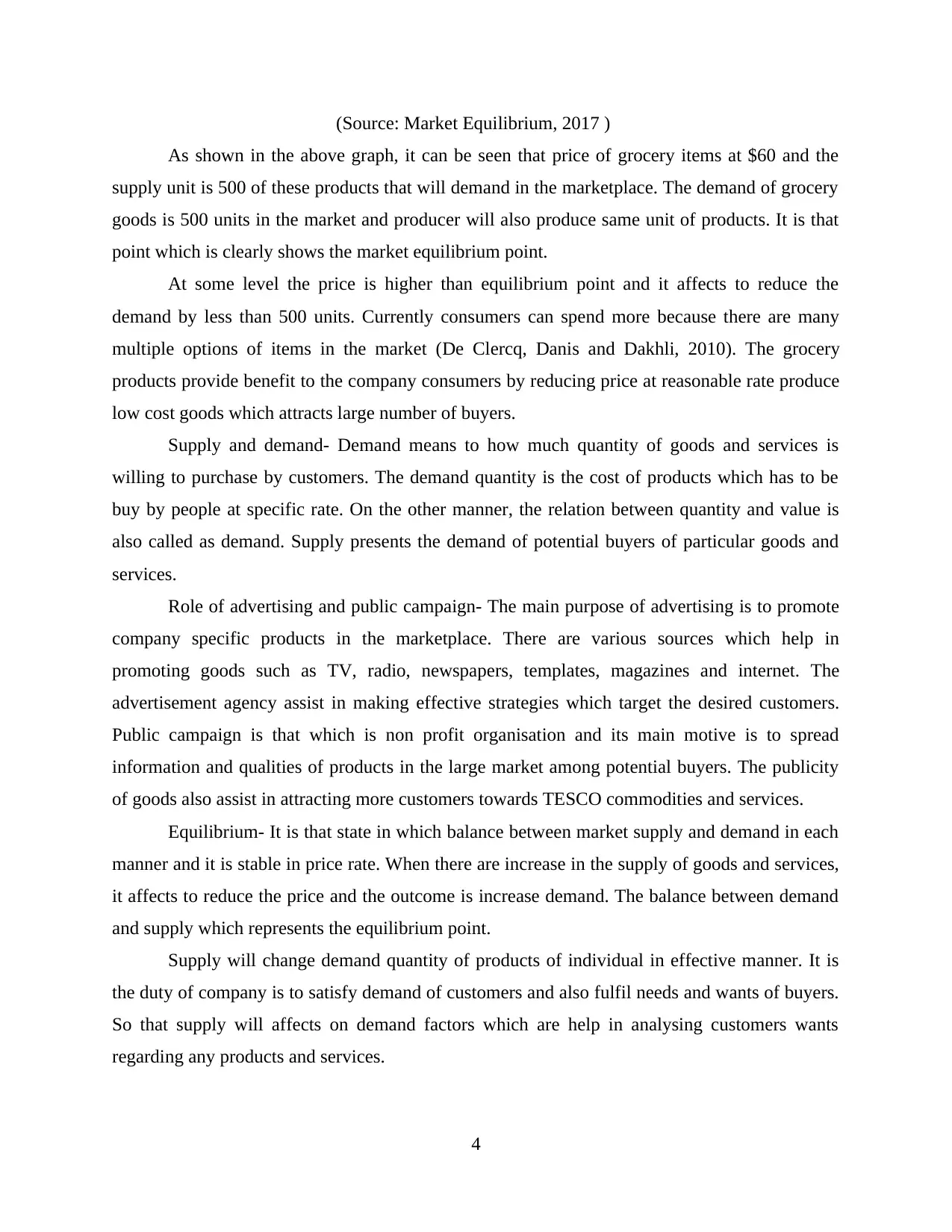
(Source: Market Equilibrium, 2017 )
As shown in the above graph, it can be seen that price of grocery items at $60 and the
supply unit is 500 of these products that will demand in the marketplace. The demand of grocery
goods is 500 units in the market and producer will also produce same unit of products. It is that
point which is clearly shows the market equilibrium point.
At some level the price is higher than equilibrium point and it affects to reduce the
demand by less than 500 units. Currently consumers can spend more because there are many
multiple options of items in the market (De Clercq, Danis and Dakhli, 2010). The grocery
products provide benefit to the company consumers by reducing price at reasonable rate produce
low cost goods which attracts large number of buyers.
Supply and demand- Demand means to how much quantity of goods and services is
willing to purchase by customers. The demand quantity is the cost of products which has to be
buy by people at specific rate. On the other manner, the relation between quantity and value is
also called as demand. Supply presents the demand of potential buyers of particular goods and
services.
Role of advertising and public campaign- The main purpose of advertising is to promote
company specific products in the marketplace. There are various sources which help in
promoting goods such as TV, radio, newspapers, templates, magazines and internet. The
advertisement agency assist in making effective strategies which target the desired customers.
Public campaign is that which is non profit organisation and its main motive is to spread
information and qualities of products in the large market among potential buyers. The publicity
of goods also assist in attracting more customers towards TESCO commodities and services.
Equilibrium- It is that state in which balance between market supply and demand in each
manner and it is stable in price rate. When there are increase in the supply of goods and services,
it affects to reduce the price and the outcome is increase demand. The balance between demand
and supply which represents the equilibrium point.
Supply will change demand quantity of products of individual in effective manner. It is
the duty of company is to satisfy demand of customers and also fulfil needs and wants of buyers.
So that supply will affects on demand factors which are help in analysing customers wants
regarding any products and services.
4
As shown in the above graph, it can be seen that price of grocery items at $60 and the
supply unit is 500 of these products that will demand in the marketplace. The demand of grocery
goods is 500 units in the market and producer will also produce same unit of products. It is that
point which is clearly shows the market equilibrium point.
At some level the price is higher than equilibrium point and it affects to reduce the
demand by less than 500 units. Currently consumers can spend more because there are many
multiple options of items in the market (De Clercq, Danis and Dakhli, 2010). The grocery
products provide benefit to the company consumers by reducing price at reasonable rate produce
low cost goods which attracts large number of buyers.
Supply and demand- Demand means to how much quantity of goods and services is
willing to purchase by customers. The demand quantity is the cost of products which has to be
buy by people at specific rate. On the other manner, the relation between quantity and value is
also called as demand. Supply presents the demand of potential buyers of particular goods and
services.
Role of advertising and public campaign- The main purpose of advertising is to promote
company specific products in the marketplace. There are various sources which help in
promoting goods such as TV, radio, newspapers, templates, magazines and internet. The
advertisement agency assist in making effective strategies which target the desired customers.
Public campaign is that which is non profit organisation and its main motive is to spread
information and qualities of products in the large market among potential buyers. The publicity
of goods also assist in attracting more customers towards TESCO commodities and services.
Equilibrium- It is that state in which balance between market supply and demand in each
manner and it is stable in price rate. When there are increase in the supply of goods and services,
it affects to reduce the price and the outcome is increase demand. The balance between demand
and supply which represents the equilibrium point.
Supply will change demand quantity of products of individual in effective manner. It is
the duty of company is to satisfy demand of customers and also fulfil needs and wants of buyers.
So that supply will affects on demand factors which are help in analysing customers wants
regarding any products and services.
4
Paraphrase This Document
Need a fresh take? Get an instant paraphrase of this document with our AI Paraphraser
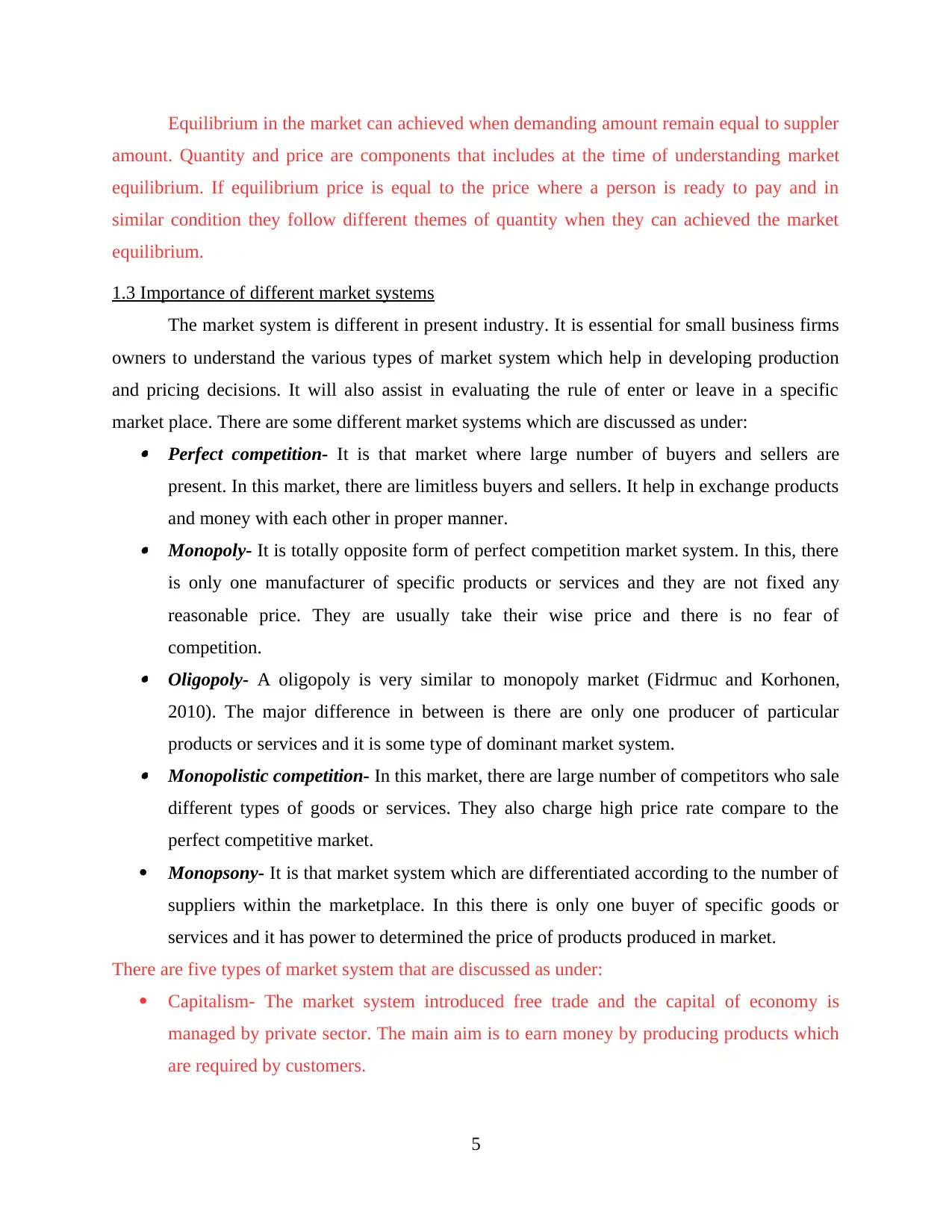
Equilibrium in the market can achieved when demanding amount remain equal to suppler
amount. Quantity and price are components that includes at the time of understanding market
equilibrium. If equilibrium price is equal to the price where a person is ready to pay and in
similar condition they follow different themes of quantity when they can achieved the market
equilibrium.
1.3 Importance of different market systems
The market system is different in present industry. It is essential for small business firms
owners to understand the various types of market system which help in developing production
and pricing decisions. It will also assist in evaluating the rule of enter or leave in a specific
market place. There are some different market systems which are discussed as under: Perfect competition- It is that market where large number of buyers and sellers are
present. In this market, there are limitless buyers and sellers. It help in exchange products
and money with each other in proper manner. Monopoly- It is totally opposite form of perfect competition market system. In this, there
is only one manufacturer of specific products or services and they are not fixed any
reasonable price. They are usually take their wise price and there is no fear of
competition. Oligopoly- A oligopoly is very similar to monopoly market (Fidrmuc and Korhonen,
2010). The major difference in between is there are only one producer of particular
products or services and it is some type of dominant market system. Monopolistic competition- In this market, there are large number of competitors who sale
different types of goods or services. They also charge high price rate compare to the
perfect competitive market.
Monopsony- It is that market system which are differentiated according to the number of
suppliers within the marketplace. In this there is only one buyer of specific goods or
services and it has power to determined the price of products produced in market.
There are five types of market system that are discussed as under:
Capitalism- The market system introduced free trade and the capital of economy is
managed by private sector. The main aim is to earn money by producing products which
are required by customers.
5
amount. Quantity and price are components that includes at the time of understanding market
equilibrium. If equilibrium price is equal to the price where a person is ready to pay and in
similar condition they follow different themes of quantity when they can achieved the market
equilibrium.
1.3 Importance of different market systems
The market system is different in present industry. It is essential for small business firms
owners to understand the various types of market system which help in developing production
and pricing decisions. It will also assist in evaluating the rule of enter or leave in a specific
market place. There are some different market systems which are discussed as under: Perfect competition- It is that market where large number of buyers and sellers are
present. In this market, there are limitless buyers and sellers. It help in exchange products
and money with each other in proper manner. Monopoly- It is totally opposite form of perfect competition market system. In this, there
is only one manufacturer of specific products or services and they are not fixed any
reasonable price. They are usually take their wise price and there is no fear of
competition. Oligopoly- A oligopoly is very similar to monopoly market (Fidrmuc and Korhonen,
2010). The major difference in between is there are only one producer of particular
products or services and it is some type of dominant market system. Monopolistic competition- In this market, there are large number of competitors who sale
different types of goods or services. They also charge high price rate compare to the
perfect competitive market.
Monopsony- It is that market system which are differentiated according to the number of
suppliers within the marketplace. In this there is only one buyer of specific goods or
services and it has power to determined the price of products produced in market.
There are five types of market system that are discussed as under:
Capitalism- The market system introduced free trade and the capital of economy is
managed by private sector. The main aim is to earn money by producing products which
are required by customers.
5
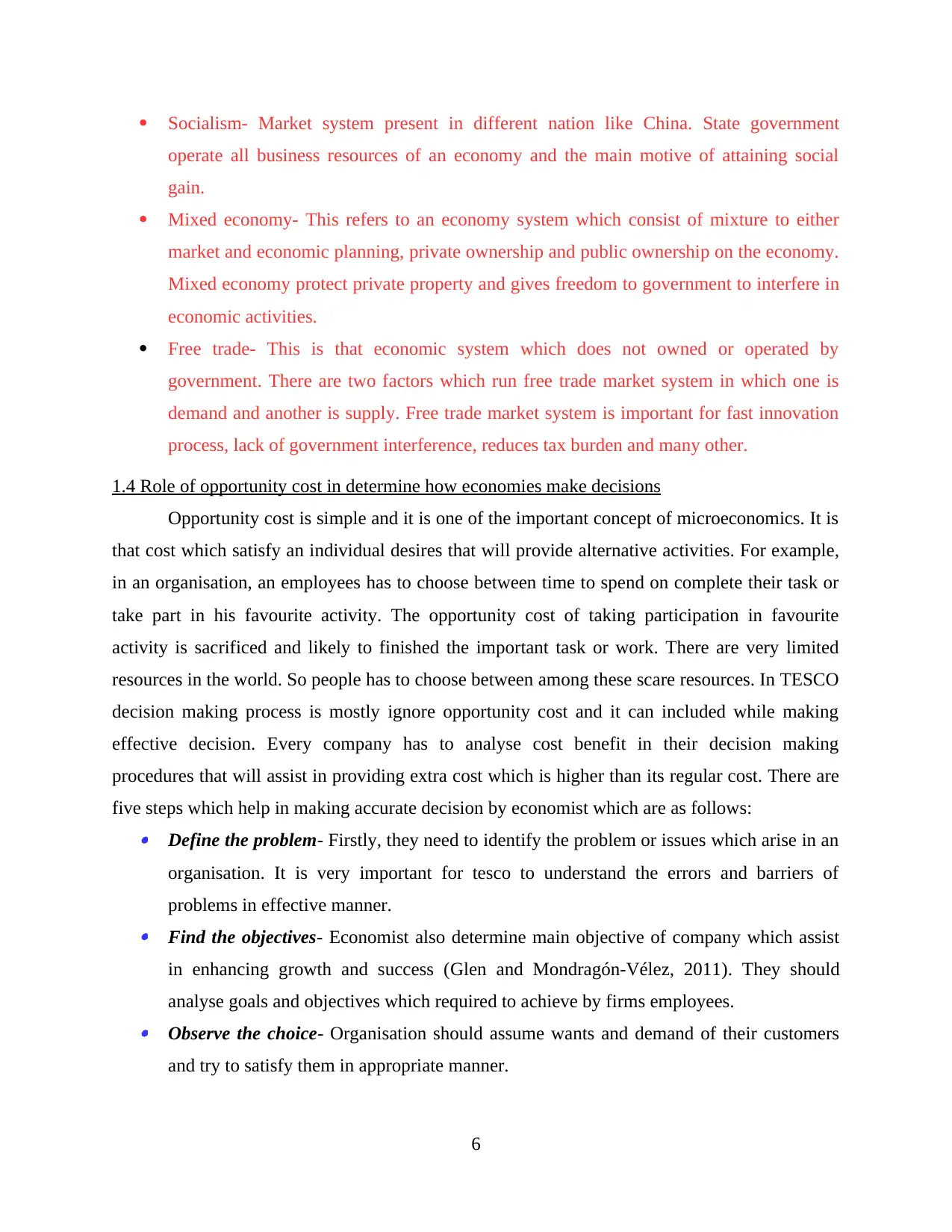
Socialism- Market system present in different nation like China. State government
operate all business resources of an economy and the main motive of attaining social
gain.
Mixed economy- This refers to an economy system which consist of mixture to either
market and economic planning, private ownership and public ownership on the economy.
Mixed economy protect private property and gives freedom to government to interfere in
economic activities.
Free trade- This is that economic system which does not owned or operated by
government. There are two factors which run free trade market system in which one is
demand and another is supply. Free trade market system is important for fast innovation
process, lack of government interference, reduces tax burden and many other.
1.4 Role of opportunity cost in determine how economies make decisions
Opportunity cost is simple and it is one of the important concept of microeconomics. It is
that cost which satisfy an individual desires that will provide alternative activities. For example,
in an organisation, an employees has to choose between time to spend on complete their task or
take part in his favourite activity. The opportunity cost of taking participation in favourite
activity is sacrificed and likely to finished the important task or work. There are very limited
resources in the world. So people has to choose between among these scare resources. In TESCO
decision making process is mostly ignore opportunity cost and it can included while making
effective decision. Every company has to analyse cost benefit in their decision making
procedures that will assist in providing extra cost which is higher than its regular cost. There are
five steps which help in making accurate decision by economist which are as follows: Define the problem- Firstly, they need to identify the problem or issues which arise in an
organisation. It is very important for tesco to understand the errors and barriers of
problems in effective manner. Find the objectives- Economist also determine main objective of company which assist
in enhancing growth and success (Glen and Mondragón-Vélez, 2011). They should
analyse goals and objectives which required to achieve by firms employees. Observe the choice- Organisation should assume wants and demand of their customers
and try to satisfy them in appropriate manner.
6
operate all business resources of an economy and the main motive of attaining social
gain.
Mixed economy- This refers to an economy system which consist of mixture to either
market and economic planning, private ownership and public ownership on the economy.
Mixed economy protect private property and gives freedom to government to interfere in
economic activities.
Free trade- This is that economic system which does not owned or operated by
government. There are two factors which run free trade market system in which one is
demand and another is supply. Free trade market system is important for fast innovation
process, lack of government interference, reduces tax burden and many other.
1.4 Role of opportunity cost in determine how economies make decisions
Opportunity cost is simple and it is one of the important concept of microeconomics. It is
that cost which satisfy an individual desires that will provide alternative activities. For example,
in an organisation, an employees has to choose between time to spend on complete their task or
take part in his favourite activity. The opportunity cost of taking participation in favourite
activity is sacrificed and likely to finished the important task or work. There are very limited
resources in the world. So people has to choose between among these scare resources. In TESCO
decision making process is mostly ignore opportunity cost and it can included while making
effective decision. Every company has to analyse cost benefit in their decision making
procedures that will assist in providing extra cost which is higher than its regular cost. There are
five steps which help in making accurate decision by economist which are as follows: Define the problem- Firstly, they need to identify the problem or issues which arise in an
organisation. It is very important for tesco to understand the errors and barriers of
problems in effective manner. Find the objectives- Economist also determine main objective of company which assist
in enhancing growth and success (Glen and Mondragón-Vélez, 2011). They should
analyse goals and objectives which required to achieve by firms employees. Observe the choice- Organisation should assume wants and demand of their customers
and try to satisfy them in appropriate manner.
6
⊘ This is a preview!⊘
Do you want full access?
Subscribe today to unlock all pages.

Trusted by 1+ million students worldwide
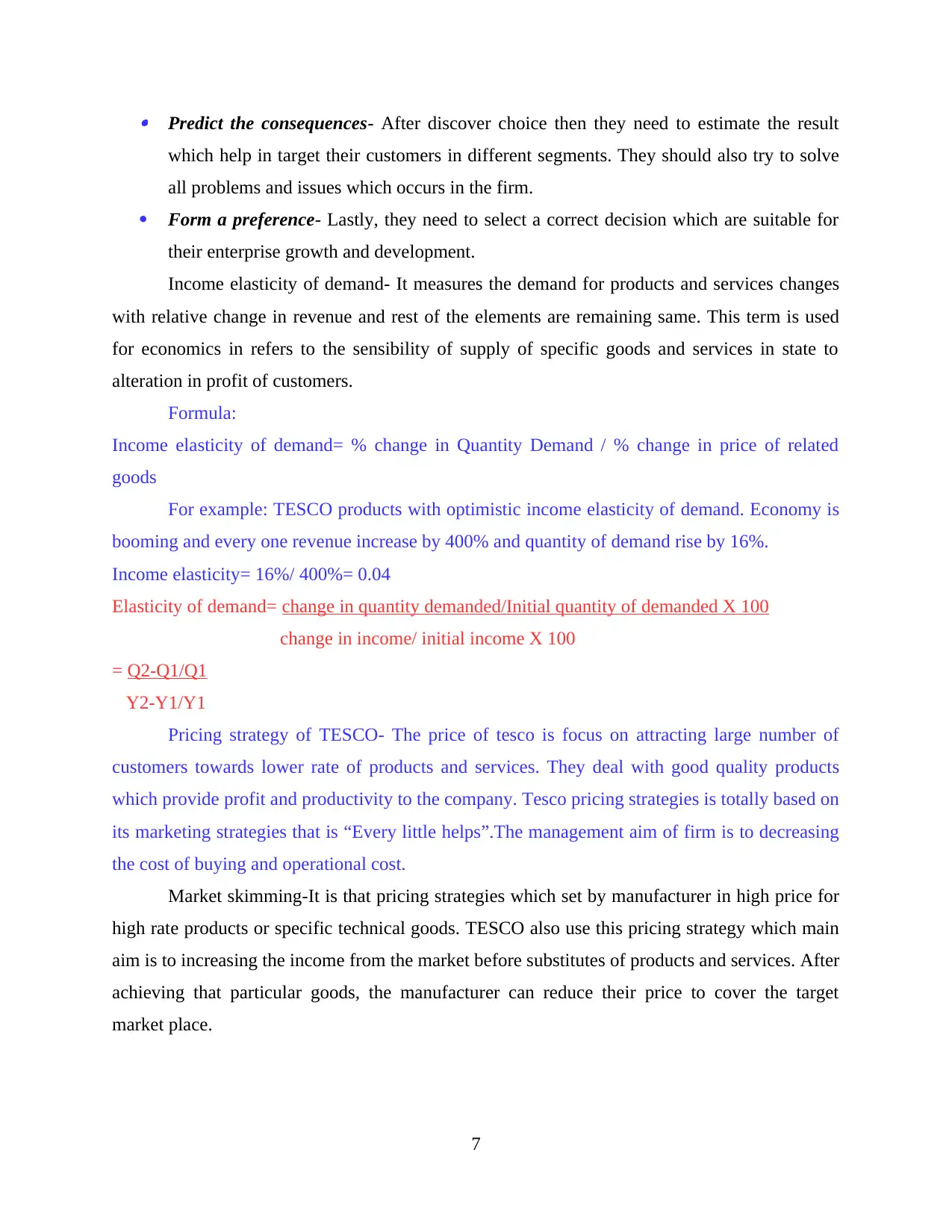
Predict the consequences- After discover choice then they need to estimate the result
which help in target their customers in different segments. They should also try to solve
all problems and issues which occurs in the firm.
Form a preference- Lastly, they need to select a correct decision which are suitable for
their enterprise growth and development.
Income elasticity of demand- It measures the demand for products and services changes
with relative change in revenue and rest of the elements are remaining same. This term is used
for economics in refers to the sensibility of supply of specific goods and services in state to
alteration in profit of customers.
Formula:
Income elasticity of demand= % change in Quantity Demand / % change in price of related
goods
For example: TESCO products with optimistic income elasticity of demand. Economy is
booming and every one revenue increase by 400% and quantity of demand rise by 16%.
Income elasticity= 16%/ 400%= 0.04
Elasticity of demand= change in quantity demanded/Initial quantity of demanded X 100
change in income/ initial income X 100
= Q2-Q1/Q1
Y2-Y1/Y1
Pricing strategy of TESCO- The price of tesco is focus on attracting large number of
customers towards lower rate of products and services. They deal with good quality products
which provide profit and productivity to the company. Tesco pricing strategies is totally based on
its marketing strategies that is “Every little helps”.The management aim of firm is to decreasing
the cost of buying and operational cost.
Market skimming-It is that pricing strategies which set by manufacturer in high price for
high rate products or specific technical goods. TESCO also use this pricing strategy which main
aim is to increasing the income from the market before substitutes of products and services. After
achieving that particular goods, the manufacturer can reduce their price to cover the target
market place.
7
which help in target their customers in different segments. They should also try to solve
all problems and issues which occurs in the firm.
Form a preference- Lastly, they need to select a correct decision which are suitable for
their enterprise growth and development.
Income elasticity of demand- It measures the demand for products and services changes
with relative change in revenue and rest of the elements are remaining same. This term is used
for economics in refers to the sensibility of supply of specific goods and services in state to
alteration in profit of customers.
Formula:
Income elasticity of demand= % change in Quantity Demand / % change in price of related
goods
For example: TESCO products with optimistic income elasticity of demand. Economy is
booming and every one revenue increase by 400% and quantity of demand rise by 16%.
Income elasticity= 16%/ 400%= 0.04
Elasticity of demand= change in quantity demanded/Initial quantity of demanded X 100
change in income/ initial income X 100
= Q2-Q1/Q1
Y2-Y1/Y1
Pricing strategy of TESCO- The price of tesco is focus on attracting large number of
customers towards lower rate of products and services. They deal with good quality products
which provide profit and productivity to the company. Tesco pricing strategies is totally based on
its marketing strategies that is “Every little helps”.The management aim of firm is to decreasing
the cost of buying and operational cost.
Market skimming-It is that pricing strategies which set by manufacturer in high price for
high rate products or specific technical goods. TESCO also use this pricing strategy which main
aim is to increasing the income from the market before substitutes of products and services. After
achieving that particular goods, the manufacturer can reduce their price to cover the target
market place.
7
Paraphrase This Document
Need a fresh take? Get an instant paraphrase of this document with our AI Paraphraser
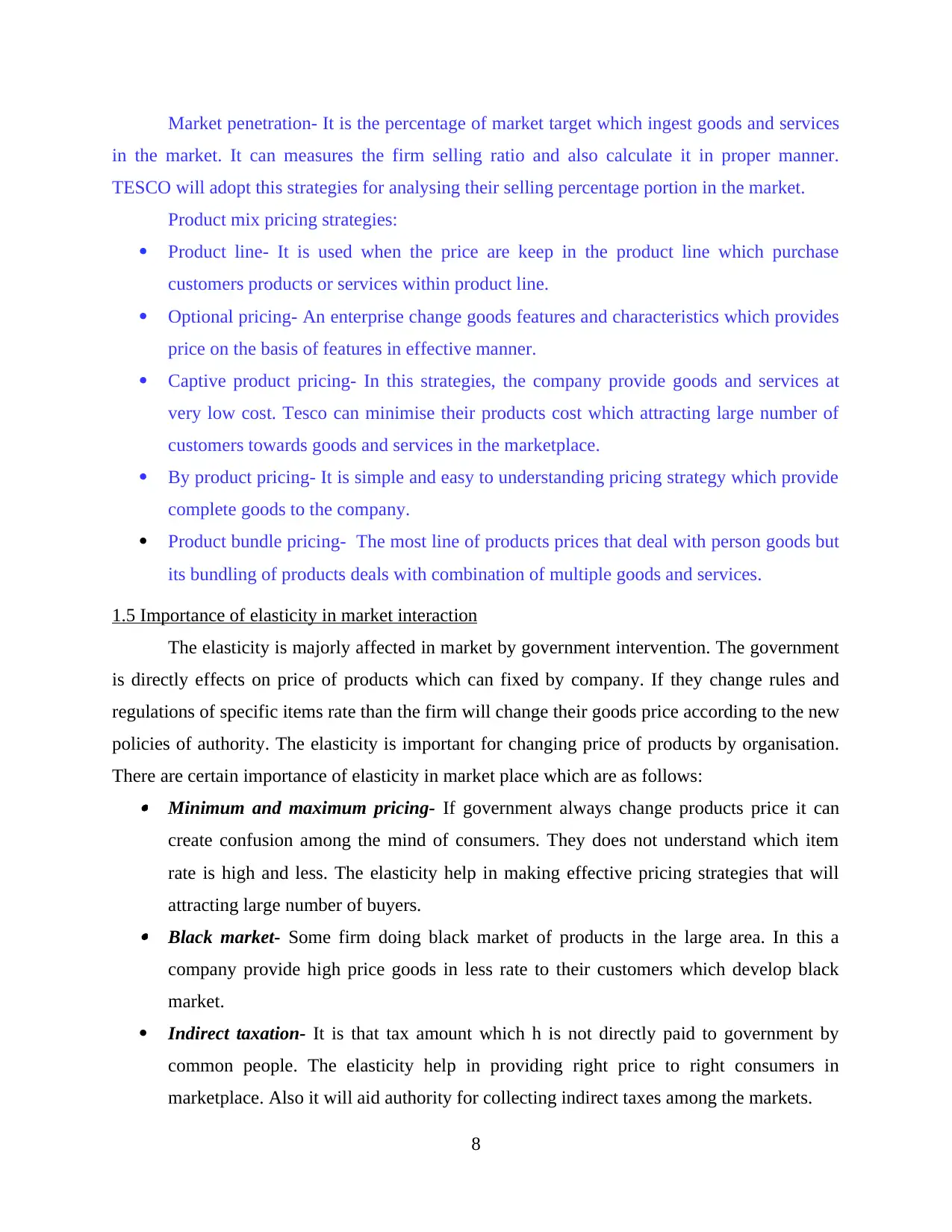
Market penetration- It is the percentage of market target which ingest goods and services
in the market. It can measures the firm selling ratio and also calculate it in proper manner.
TESCO will adopt this strategies for analysing their selling percentage portion in the market.
Product mix pricing strategies:
Product line- It is used when the price are keep in the product line which purchase
customers products or services within product line.
Optional pricing- An enterprise change goods features and characteristics which provides
price on the basis of features in effective manner.
Captive product pricing- In this strategies, the company provide goods and services at
very low cost. Tesco can minimise their products cost which attracting large number of
customers towards goods and services in the marketplace.
By product pricing- It is simple and easy to understanding pricing strategy which provide
complete goods to the company.
Product bundle pricing- The most line of products prices that deal with person goods but
its bundling of products deals with combination of multiple goods and services.
1.5 Importance of elasticity in market interaction
The elasticity is majorly affected in market by government intervention. The government
is directly effects on price of products which can fixed by company. If they change rules and
regulations of specific items rate than the firm will change their goods price according to the new
policies of authority. The elasticity is important for changing price of products by organisation.
There are certain importance of elasticity in market place which are as follows: Minimum and maximum pricing- If government always change products price it can
create confusion among the mind of consumers. They does not understand which item
rate is high and less. The elasticity help in making effective pricing strategies that will
attracting large number of buyers. Black market- Some firm doing black market of products in the large area. In this a
company provide high price goods in less rate to their customers which develop black
market.
Indirect taxation- It is that tax amount which h is not directly paid to government by
common people. The elasticity help in providing right price to right consumers in
marketplace. Also it will aid authority for collecting indirect taxes among the markets.
8
in the market. It can measures the firm selling ratio and also calculate it in proper manner.
TESCO will adopt this strategies for analysing their selling percentage portion in the market.
Product mix pricing strategies:
Product line- It is used when the price are keep in the product line which purchase
customers products or services within product line.
Optional pricing- An enterprise change goods features and characteristics which provides
price on the basis of features in effective manner.
Captive product pricing- In this strategies, the company provide goods and services at
very low cost. Tesco can minimise their products cost which attracting large number of
customers towards goods and services in the marketplace.
By product pricing- It is simple and easy to understanding pricing strategy which provide
complete goods to the company.
Product bundle pricing- The most line of products prices that deal with person goods but
its bundling of products deals with combination of multiple goods and services.
1.5 Importance of elasticity in market interaction
The elasticity is majorly affected in market by government intervention. The government
is directly effects on price of products which can fixed by company. If they change rules and
regulations of specific items rate than the firm will change their goods price according to the new
policies of authority. The elasticity is important for changing price of products by organisation.
There are certain importance of elasticity in market place which are as follows: Minimum and maximum pricing- If government always change products price it can
create confusion among the mind of consumers. They does not understand which item
rate is high and less. The elasticity help in making effective pricing strategies that will
attracting large number of buyers. Black market- Some firm doing black market of products in the large area. In this a
company provide high price goods in less rate to their customers which develop black
market.
Indirect taxation- It is that tax amount which h is not directly paid to government by
common people. The elasticity help in providing right price to right consumers in
marketplace. Also it will aid authority for collecting indirect taxes among the markets.
8
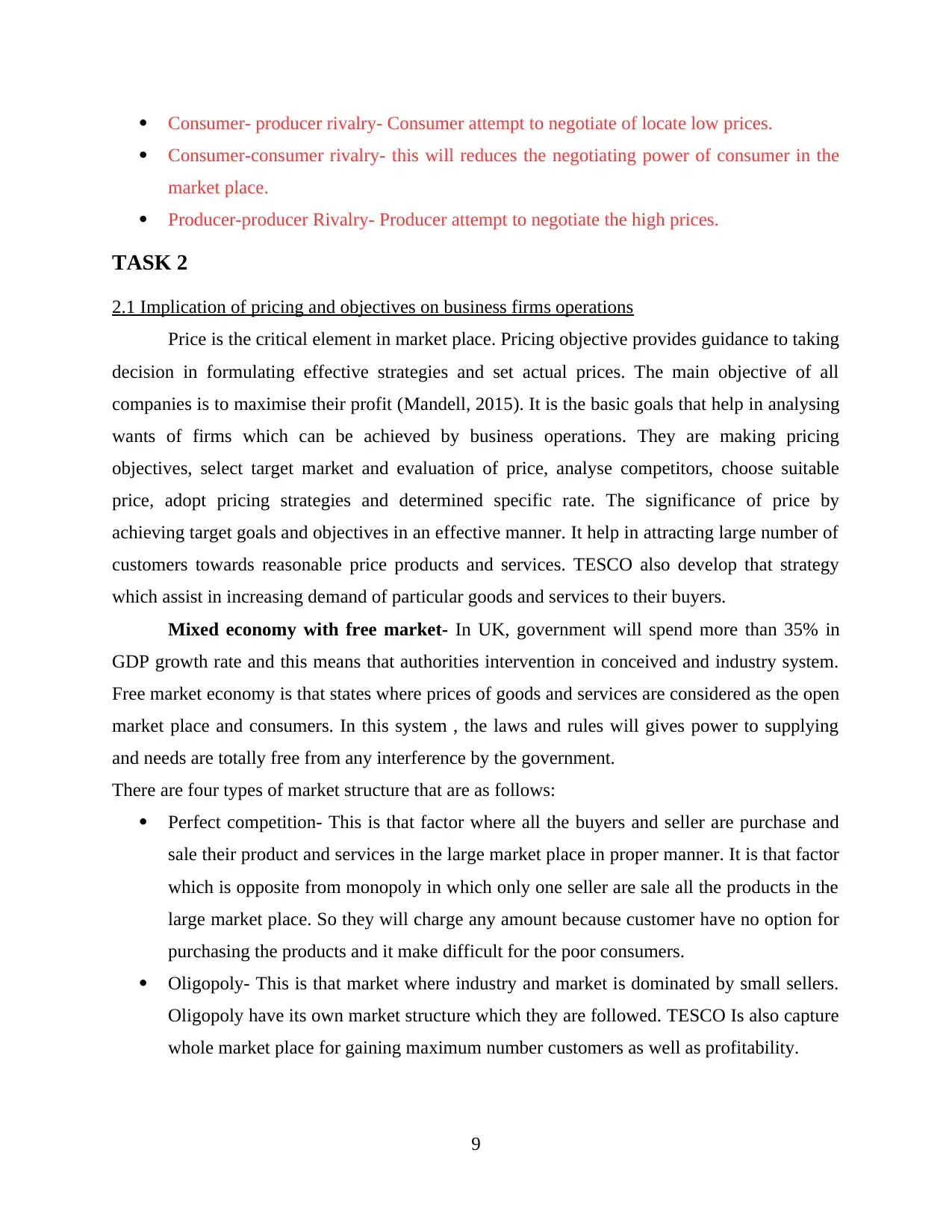
Consumer- producer rivalry- Consumer attempt to negotiate of locate low prices.
Consumer-consumer rivalry- this will reduces the negotiating power of consumer in the
market place.
Producer-producer Rivalry- Producer attempt to negotiate the high prices.
TASK 2
2.1 Implication of pricing and objectives on business firms operations
Price is the critical element in market place. Pricing objective provides guidance to taking
decision in formulating effective strategies and set actual prices. The main objective of all
companies is to maximise their profit (Mandell, 2015). It is the basic goals that help in analysing
wants of firms which can be achieved by business operations. They are making pricing
objectives, select target market and evaluation of price, analyse competitors, choose suitable
price, adopt pricing strategies and determined specific rate. The significance of price by
achieving target goals and objectives in an effective manner. It help in attracting large number of
customers towards reasonable price products and services. TESCO also develop that strategy
which assist in increasing demand of particular goods and services to their buyers.
Mixed economy with free market- In UK, government will spend more than 35% in
GDP growth rate and this means that authorities intervention in conceived and industry system.
Free market economy is that states where prices of goods and services are considered as the open
market place and consumers. In this system , the laws and rules will gives power to supplying
and needs are totally free from any interference by the government.
There are four types of market structure that are as follows:
Perfect competition- This is that factor where all the buyers and seller are purchase and
sale their product and services in the large market place in proper manner. It is that factor
which is opposite from monopoly in which only one seller are sale all the products in the
large market place. So they will charge any amount because customer have no option for
purchasing the products and it make difficult for the poor consumers.
Oligopoly- This is that market where industry and market is dominated by small sellers.
Oligopoly have its own market structure which they are followed. TESCO Is also capture
whole market place for gaining maximum number customers as well as profitability.
9
Consumer-consumer rivalry- this will reduces the negotiating power of consumer in the
market place.
Producer-producer Rivalry- Producer attempt to negotiate the high prices.
TASK 2
2.1 Implication of pricing and objectives on business firms operations
Price is the critical element in market place. Pricing objective provides guidance to taking
decision in formulating effective strategies and set actual prices. The main objective of all
companies is to maximise their profit (Mandell, 2015). It is the basic goals that help in analysing
wants of firms which can be achieved by business operations. They are making pricing
objectives, select target market and evaluation of price, analyse competitors, choose suitable
price, adopt pricing strategies and determined specific rate. The significance of price by
achieving target goals and objectives in an effective manner. It help in attracting large number of
customers towards reasonable price products and services. TESCO also develop that strategy
which assist in increasing demand of particular goods and services to their buyers.
Mixed economy with free market- In UK, government will spend more than 35% in
GDP growth rate and this means that authorities intervention in conceived and industry system.
Free market economy is that states where prices of goods and services are considered as the open
market place and consumers. In this system , the laws and rules will gives power to supplying
and needs are totally free from any interference by the government.
There are four types of market structure that are as follows:
Perfect competition- This is that factor where all the buyers and seller are purchase and
sale their product and services in the large market place in proper manner. It is that factor
which is opposite from monopoly in which only one seller are sale all the products in the
large market place. So they will charge any amount because customer have no option for
purchasing the products and it make difficult for the poor consumers.
Oligopoly- This is that market where industry and market is dominated by small sellers.
Oligopoly have its own market structure which they are followed. TESCO Is also capture
whole market place for gaining maximum number customers as well as profitability.
9
⊘ This is a preview!⊘
Do you want full access?
Subscribe today to unlock all pages.

Trusted by 1+ million students worldwide
1 out of 24
Related Documents
Your All-in-One AI-Powered Toolkit for Academic Success.
+13062052269
info@desklib.com
Available 24*7 on WhatsApp / Email
![[object Object]](/_next/static/media/star-bottom.7253800d.svg)
Unlock your academic potential
Copyright © 2020–2025 A2Z Services. All Rights Reserved. Developed and managed by ZUCOL.





